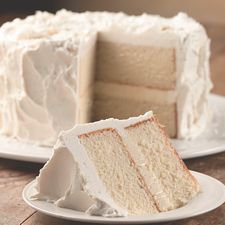Italian Buttercream
This is the frosting that you'll find on many wedding cakes. Its silky texture is unparalleled, it pipes like a dream, and can be flavored and colored in as many ways as you can imagine. While it takes a little time to make, it freezes quite well. It's great to have on hand for unexpected occasions.

Hands-on: 60 min to 2 hr | Yield: 7 to 7 1/2 cups
Ingredients
Sugar Syrup
- 1 1/4 cups granulated sugar
- 1/2 cup water
Meringue
- 1/2 cup meringue powder*
- 1 cup water
- 1/4 teaspoon salt
- 1/3 cup granulated sugar
Frosting
- 3 cups (6 sticks) unsalted butter
- 1/2 to 3/4 cup vegetable shortening (optional)
- 1 teaspoon to 2 tablespoons flavoring
Instructions
Sugar Syrup
- Combine the sugar and water in a small, nonstick (preferable, if you have one) saucepan. Bring to a boil over medium heat, stirring occasionally until the sugar dissolves. Cook, without stirring, until the syrup reaches at least 240 degrees F. It can go as high as 248 to 250 degrees F. Just be sure it's within those temperatures before you take it off the stove.
Meringue
- While the syrup is cooking, combine the meringue powder, water, and salt in the bowl of your mixer. Beat at high speed with the whisk attachment until the mixture first looks foamy, then turns white, and you begin to see tracks in the bowl. At this point, slowly sprinkle in the sugar with the mixer running. Increase the speed to high and beat until the mixture is stiff.
- When the syrups gets above 240 degrees F (110 degrees C) and before it gets above 250 degrees F (121 degrees C), remove it from the heat and with the mixer running at low speed, pour it down the side of the mixing bowl(not on the whisk or beaters if you can avoid it; that will send the syrup flying and start spinning sugar threads instead of incorporating it). Once the syrup is all in, leave the mixer running until the mixture cools to 80 degrees F. You can help this process along by wrapping an ice pack around the mixing bowl.
Frosting
- Once the meringue is cool, add the butter, a few pieces at a time, with the mixer running at medium to medium-high speed. The meringue will deflate a bit, and may begin to look curdled. Don't lose heart! This ugly "adolescent" stage is normal. Just keep the mixer running and adding the butter.
- Soon the frosting will begin to bring itself together around the whisk, then in the rest of the bowl. Once most of the butter is in, add vanilla extract or your choice of flavorings. If you're using the frosting for decorations, add the vegetable shortening in chunks at this point.
- Use the buttercream within 4 hours, or refrigerate until needed.
Notes
* If you want to use fresh egg whites instead of meringue powder, you'll need 8 large whites (room temperature), combined with 1 teaspoon cream of tartar. Pasteurized egg whites in cartons won't work for this purpose.
Before you start, make sure you have a digital or candy thermometer that will read up to 300 degrees F for the and a small (nonstick, if you have it) saucepan for the sugar syrup.
While it's possible to do this with a hand mixer, it's strongly recommended that a stand mixer be used. You'll need your hands free to pour the syrup and add the butter.
If you plan to make piped roses, or if the cake you're frosting is going to spend any length of time in a warm place, adding a bit of vegetable shortening to the recipe will help any piping or decorations hold their shape better; the shortening has a higher melting point than butter, and helps the frosting to stay more stable in warm conditions.
Buttercream will keep up to 1 week in the refrigerator (longer than that, and you may see some mold start to form). It freezes beautifully. To use from frozen, defrost in the refrigerator overnight, then let it come to room temperature before using. If you see any weeping or separation, toss the frosting in the mixer and whip it briefly to bring it back together.
If you're coloring the frosting, be sure to use gel or paste colors, not liquid ones; they'll cause the frosting to break.
If you're not going to use the frosting right away, consider dividing it into several smaller containers before refrigerating or freezing it. The smaller amounts will take less time to come to room temperature, and you'll be able to work with the frosting sooner.
Nutrition
Per serving: Calories: 213 Calories from Fat: 162 Total Fat: 18g Saturated Fat: 12g Trans Fat: 1g. Cholesterol: 49mg Sodium: 36mg Total Carbohydrate: 12g Dietary Fiber: 0g Sugars: 12g Protein: 1g
Attribution
Recipe and photo used with permission from: King Arthur Flour

